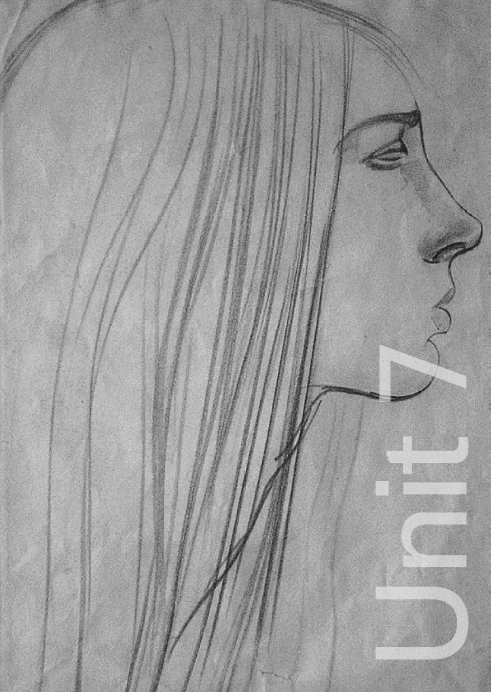UNIT 7A SELF IMAGE
ABOUT THE UNIT
In this unit, pupils explore their personal identity as a starting point.
They create images that reflect their ideas of themselves, working from
observation, memory and imagination. They develop skills using traditional
materials and processes and have the opportunity to combine traditional and
digital media. They learn about the ideas, methods and approaches used by other
artists who have made images of themselves and/or portrayed others.
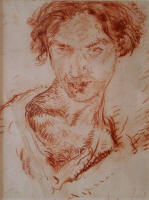
|
Jacob Epstein ‘Self-portrait’ 1901 (red chalk) GR63 (PORTRAITS) |
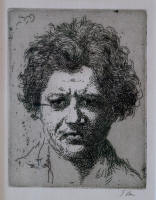
|
Augustus John ‘Jacob Epstein’ 1905/6 (etching) GR142 (PORTRAITS) Compare the two pictures of Epstein completed 4-5 years apart. The
self-confidence, handsome possibly arrogant self-portrait contrasts with the
plumper, more serious possibly even jaded portrait, made by his friend Augustus
John. Discuss the image we would like to put out to the world, to other friends
and acquaintances and how we can do it through our speech, actions, belongings
and appearance.
|
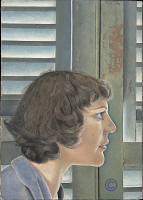
|
Jacob Epstein ‘Profile of a Young Girl’ (pencil) GR66 Lucian Freud ‘Portrait
of Kitty’ (oil) GR96 (PORTRAITS)
Study these profiles and try to draw a profile of someone (projecting a
shadow with an overhead projector) possibly developing it into a collaged
silhouette. Use a digital camera to develop profile photographs and work from
this image of oneself that one is not used to seeing in order to develop a
painting combined perhaps with a suitable background that reflects your own
environment (house, room, football field etc) or an environment you would aspire
to. Compare profiles (that avoid eye contact) with portraits that look out at
and acknowledge/challenge viewer. |
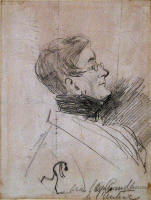
|
William Makepeace Thackeray ‘Self-Portrait’ (pencil) GR242 (PORTRAITS) |
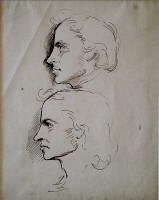
|
George Richmond ‘Two Portrait Sketches of Samuel Palmer’ (pen and ink) GR201
(PORTRAITS) Both of these are again profiles and are to some extent cartoon-like
characterisations of the sitter. Pupils could work from photographs of
themselves from which they develop cartoons of themselves by exaggerating
features etc and explore ways of depicting moods and feelings, situations they
may have been in and how they relate to other people in their life.
|
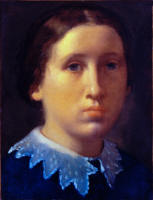
|
Edgar Degas ‘Portrait of Marguerite, the Artist’s Sister’ (oils) GR33
(PORTRAITS) This painting concentrates on the head of the sitter and brings the viewer
into close proximity with her, creating a very intimate portrait. Pupils could
be asked to paint someone that’s close to them within their family alongside
their self-portrait trying to show the bond or relationship through the painting.
|
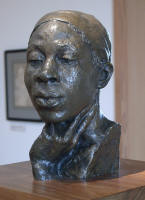
|
Sally Ryan ‘The Martinique (bronze) GR224 (PORTRAITS) |
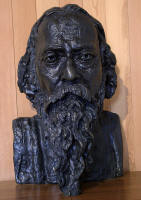 |
Jacob Epstein ‘Mask of Rabindranath Tagore’ (bronze) GR82 (PORTRAITS) These sculptures can be used to introduce for discussion ideas about
sculptural portraits, ethnic diversity and celebrity portraits (Tagore was a
famous Indian poet and writer pictured with Epstein in ‘A Shared Vision’ (P33)
|
The gallery has an Education Pack based on family called People and Portraits
for purchase in the gallery shop.
UNIT 7B WHAT’S IN A BUILDING?
ABOUT THE UNIT
In this unit, pupils explore landscape as the starting point for two and
three-dimensional work. They collect visual and other information by visiting a
landscape and by studying the methods, approaches and intentions of artists and
craftspeople that use the environment as inspiration. They manipulate the visual
and tactile qualities of materials to convey mood and feeling about a landscape
and construct textile-based work.
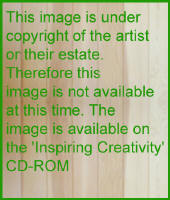 |
Walter Sickert ‘San Marco, Venice (watercolour) GR236 (LANDSCAPE AND TOWNSCAPE)
Painted whilst he was living in Venice where he produced painted scenes to
sell to either tourists or in England. This picture could introduce pupils
to producing quickly sketched observation drawings of buildings or
architectural detail collected in sketch books to be used as reference
material. Venice can also be mentioned as a place visited on the ‘grand
tour’ – can pupils develop their own local grand tour of a route looking at
quirky/interesting buildings or little details in their local area with
sketches and photos? This could be a personal choice or could follow
discussions of well known buildings –The New Art Gallery, Walsall Bus
Station, Willenhall Baths trying to list aims of architectural brief (i.e.
what the buildings needed to provide) and how successful they were thought
to be.
|
%20-%201850_small1.jpg)
|
Charles Meryon ‘The Little Bridge’ (etching) GR166 (LANDSCAPE AND TOWNSCAPE) |
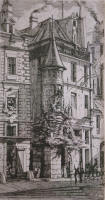
|
Charles Meryon ‘Little Tower on the Rue de La Tixeranderie’ (etching) GR165
(LANDSCAPE AND TOWNSCAPE)
Pupils could extend the drawings on either side looking at the style,
proportion, perspective and details to try to match their drawing with the
original after close study. Further research on Meryon may be rewarding as he
ranks with Piranesi as the greatest of architectural etchers, he also produced
romantic horror pictures and spent time in an asylum when he believed himself to
be Christ. |
%20-%20Nottingham%20ca%2015th%20C_small1.jpg)
|
English (Nottingham) ‘Resurrection’ c15th century (alabaster) GR349 (FIGURE
STUDIES) |
%20%20-%20Sandstone%20Goddess%20Parvati%20and%20attendants%20-%20ca%2011th-12th%20C_small1.jpg)
|
Indian ‘The Goddess Parvati and Attendants’ c11-12th century (Sandstone)
GR323 (FIGURE STUDIES)
These are both religious sculptures for contemplation when installed in a
church or temple, possibly as part of a larger and more elaborate sculptural
scheme. Pupils can follow up by collecting sketches of details of doorways,
windows, porches etc in public buildings and pay particular attention to any
sculptural work designed specifically for certain buildings. Pupils can collect
photographs and illustrations of different types of construction and of
buildings designed for different purposes. These can be developed into a 3D
piece of work – possibly a relief in clay or a building design made as a 3D
model using paper and card. |
Domestic buildings can be studied in terms of detached, semi-detached,
terraced or tower blocks. With thought given to consideration of cost, land
availability, noise levels etc.
The landscape and the environment are used as inspiration for some
Entitlement Box projects. This resource may provide an excellent inspiration for
this activity and is available from Walsall Education Development Centre, Manor
Farm, Rushall to Walsall Borough Schools.
UNIT 7C RECREATING LANDSCAPES
ABOUT THE UNIT
In this unit, pupils explore landscape as the starting point for two- and
three-dimensional work. They collect visual and other information by visiting a
landscape and by studying the methods, approaches and intentions of artists and
craftspeople that use the environment as inspiration. They manipulate the visual
and tactile qualities of materials to convey mood and feeling about a landscape
and construct textile-based work.
The expectation is to collect and record visual information
by making and annotating drawings in their sketchbooks with a view to using them
to produce a textile/assemblage piece. I have therefore selected several
landscape pictures that model the use of the sketchbook.
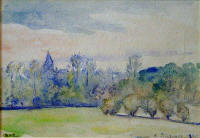
|
Camille Pissarro ‘Landscape - Eragny-sur-Epte (watercolour) GR186 (LANDSCAPE
AND TOWNSCAPE) |

|
Pierre Bonnard ‘The River Seine at Vernon’ (oil) GR7 (LANDSCAPE AND TOWNSCAPE) |
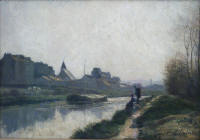
|
Stanislas Lepine ‘The Canal’ (oil) GR150 (LANDSCAPE AND TOWNSCAPE) |
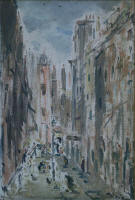
|
Filippo de Pisis ‘Street Scene in Italy’ c1936 (oil) GR184 (LANDSCAPE
AND TOWNSCAPE) |
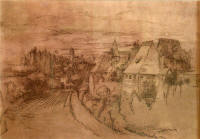 |
John Ruskin ‘Lauffenbourg’ c1863 (pencil/pen) GR215 (LANDSCAPE AND TOWNSCAPE) These introduce everyday scenes that are simplified into broad areas of
colour and pattern. The everyday can be used as a starting point and be later
developed for use in other media. The Bonnard, for example, creates an illusion
of depth by overlapping trees in progressively darker shades of green – which
would translate well to the use of appliqué shapes cut from different fabrics to
build a textile piece. The Pissarro could be drawn with fabric crayons onto
paper that is then ironed onto fabric to achieve the delicate water colour
effect.
The canal scene could be any number of locations in Walsall – and don’t heed
with the street scene, introduces examples of one point perspective.
Shire Oak School has produced an excellent Entitlement Project unit which
includes textile work inspired by drawings and photographs produced on a visit
to Stubbers Green Walsall. These use various textile techniques (e.g. silk
painting) to develop landscape designs and are truly inspirational – hire out
the box from Walsall EDC and watch the ideas flow!
|

|
Georges Rouault. ‘Three Crosses’ (etching) GR211 (RELIGIOUS ART) This is included as an example of a more powerful landscape image with its
religious imagery, loose technique, dramatic colouring and execution. This can
encourage different interpretations of the natural environment perhaps using the
urban/rural landscape or using sticks, stones etc found in the landscape as
inspirations for prints and textile pieces.
Fabric ideas can be included in the design of various practical objects –
e.g. bags, mobile phone covers, t-shirts.
|

Home |
A resource web for art teachers using the Garman Ryan Collection and the
New Art Gallery Walsall, England as a source of inspiration for the delivery of the QCA
National Curriculum 2000 art schemes of work to pupils in Key Stages 1-3 |
